Entry Database : PDB / ID : 3fieTitle Crystal structure of Clostridium botulinum neurotoxin serotype F catalytic domain with an inhibitor (inh1) BOTULINUM NEUROTOXIN TYPE F fragment of Vesicle-associated membrane protein 2 Keywords / / / / / / / / / Function / homology Function Domain/homology Component
/ / / / / / / / / / / / / / / / / / / / / / / / / / / / / / / / / / / / / / / / / / / / / / / / / / / / / / / / / / / / / / / / / / / / / / / / / / / / / / / / / / / / / / / / / / / / / / / / / / / / / / / / / / / / / / / / / / / / / / / / / / / Biological species Clostridium botulinum (bacteria)Method / / / Resolution : 2.1 Å Authors Agarwal, R. / Swaminathan, S. Journal : Nat.Struct.Mol.Biol. / Year : 2009Title : Mode of VAMP substrate recognition and inhibition of Clostridium botulinum neurotoxin F.Authors : Agarwal, R. / Schmidt, J.J. / Stafford, R.G. / Swaminathan, S. History Deposition Dec 11, 2008 Deposition site / Processing site Revision 1.0 Jun 23, 2009 Provider / Type Revision 1.1 Jul 13, 2011 Group Revision 1.2 Sep 6, 2023 Group Data collection / Database references ... Data collection / Database references / Derived calculations / Refinement description Category chem_comp_atom / chem_comp_bond ... chem_comp_atom / chem_comp_bond / database_2 / pdbx_initial_refinement_model / struct_conn / struct_ref_seq_dif / struct_site Item _database_2.pdbx_DOI / _database_2.pdbx_database_accession ... _database_2.pdbx_DOI / _database_2.pdbx_database_accession / _struct_conn.conn_type_id / _struct_conn.id / _struct_conn.pdbx_dist_value / _struct_conn.pdbx_leaving_atom_flag / _struct_conn.ptnr1_auth_asym_id / _struct_conn.ptnr1_auth_comp_id / _struct_conn.ptnr1_auth_seq_id / _struct_conn.ptnr1_label_asym_id / _struct_conn.ptnr1_label_atom_id / _struct_conn.ptnr1_label_comp_id / _struct_conn.ptnr1_label_seq_id / _struct_conn.ptnr2_auth_asym_id / _struct_conn.ptnr2_auth_comp_id / _struct_conn.ptnr2_auth_seq_id / _struct_conn.ptnr2_label_asym_id / _struct_conn.ptnr2_label_atom_id / _struct_conn.ptnr2_label_comp_id / _struct_conn.ptnr2_label_seq_id / _struct_ref_seq_dif.details / _struct_site.pdbx_auth_asym_id / _struct_site.pdbx_auth_comp_id / _struct_site.pdbx_auth_seq_id
Show all Show less
 Yorodumi
Yorodumi Open data
Open data Basic information
Basic information Components
Components Keywords
Keywords HYDROLASE / TOXIN/PROTEIN TRANSPORT /
HYDROLASE / TOXIN/PROTEIN TRANSPORT /  Clostridium botulinum / BoNT F /
Clostridium botulinum / BoNT F /  VAMP /
VAMP /  inhibitor / complex structure /
inhibitor / complex structure /  Acetylation /
Acetylation /  Cell junction / TOXIN-PROTEIN TRANSPORT COMPLEX
Cell junction / TOXIN-PROTEIN TRANSPORT COMPLEX Function and homology information
Function and homology information vesicle fusion /
vesicle fusion /  SNARE complex / Golgi to plasma membrane protein transport /
SNARE complex / Golgi to plasma membrane protein transport /  SNAP receptor activity / regulation of vesicle-mediated transport / Glutamate Neurotransmitter Release Cycle /
SNAP receptor activity / regulation of vesicle-mediated transport / Glutamate Neurotransmitter Release Cycle /  bontoxilysin / calcium-ion regulated exocytosis / positive regulation of intracellular protein transport / host cell presynaptic membrane /
bontoxilysin / calcium-ion regulated exocytosis / positive regulation of intracellular protein transport / host cell presynaptic membrane /  regulation of exocytosis / host cell cytoplasmic vesicle / neuron projection terminus / Sensory processing of sound by inner hair cells of the cochlea /
regulation of exocytosis / host cell cytoplasmic vesicle / neuron projection terminus / Sensory processing of sound by inner hair cells of the cochlea /  syntaxin-1 binding /
syntaxin-1 binding /  SNARE complex assembly /
SNARE complex assembly /  syntaxin binding / host cell cytosol /
syntaxin binding / host cell cytosol /  clathrin-coated vesicle / Lysosome Vesicle Biogenesis / Insertion of tail-anchored proteins into the endoplasmic reticulum membrane / Other interleukin signaling / Golgi Associated Vesicle Biogenesis / Insulin processing /
clathrin-coated vesicle / Lysosome Vesicle Biogenesis / Insertion of tail-anchored proteins into the endoplasmic reticulum membrane / Other interleukin signaling / Golgi Associated Vesicle Biogenesis / Insulin processing /  exocytosis / synaptic vesicle exocytosis / synaptic vesicle endocytosis / protein transmembrane transporter activity / response to glucose / vesicle-mediated transport /
exocytosis / synaptic vesicle exocytosis / synaptic vesicle endocytosis / protein transmembrane transporter activity / response to glucose / vesicle-mediated transport /  SNARE binding / secretory granule membrane /
SNARE binding / secretory granule membrane /  secretory granule / long-term synaptic potentiation / Regulation of insulin secretion / Translocation of SLC2A4 (GLUT4) to the plasma membrane /
secretory granule / long-term synaptic potentiation / Regulation of insulin secretion / Translocation of SLC2A4 (GLUT4) to the plasma membrane /  phospholipid binding / clathrin-coated endocytic vesicle membrane /
phospholipid binding / clathrin-coated endocytic vesicle membrane /  trans-Golgi network / synaptic vesicle membrane /
trans-Golgi network / synaptic vesicle membrane /  metalloendopeptidase activity / cellular response to insulin stimulus / calcium-dependent protein binding /
metalloendopeptidase activity / cellular response to insulin stimulus / calcium-dependent protein binding /  synaptic vesicle /
synaptic vesicle /  protein transport / Cargo recognition for clathrin-mediated endocytosis /
protein transport / Cargo recognition for clathrin-mediated endocytosis /  Clathrin-mediated endocytosis /
Clathrin-mediated endocytosis /  toxin activity / cytoplasmic vesicle / protein-containing complex assembly / vesicle /
toxin activity / cytoplasmic vesicle / protein-containing complex assembly / vesicle /  membrane fusion /
membrane fusion /  calmodulin binding / neuron projection / intracellular membrane-bounded organelle /
calmodulin binding / neuron projection / intracellular membrane-bounded organelle /  synapse /
synapse /  lipid binding / host cell plasma membrane / perinuclear region of cytoplasm /
lipid binding / host cell plasma membrane / perinuclear region of cytoplasm /  proteolysis / zinc ion binding / extracellular region /
proteolysis / zinc ion binding / extracellular region /  membrane /
membrane /  plasma membrane /
plasma membrane /  cytosol
cytosol
 Clostridium botulinum (bacteria)
Clostridium botulinum (bacteria) X-RAY DIFFRACTION /
X-RAY DIFFRACTION /  SYNCHROTRON /
SYNCHROTRON /  MOLECULAR REPLACEMENT / Resolution: 2.1 Å
MOLECULAR REPLACEMENT / Resolution: 2.1 Å  Authors
Authors Citation
Citation Journal: Nat.Struct.Mol.Biol. / Year: 2009
Journal: Nat.Struct.Mol.Biol. / Year: 2009 Structure visualization
Structure visualization Molmil
Molmil Jmol/JSmol
Jmol/JSmol Downloads & links
Downloads & links Download
Download 3fie.cif.gz
3fie.cif.gz PDBx/mmCIF format
PDBx/mmCIF format pdb3fie.ent.gz
pdb3fie.ent.gz PDB format
PDB format 3fie.json.gz
3fie.json.gz PDBx/mmJSON format
PDBx/mmJSON format Other downloads
Other downloads https://data.pdbj.org/pub/pdb/validation_reports/fi/3fie
https://data.pdbj.org/pub/pdb/validation_reports/fi/3fie ftp://data.pdbj.org/pub/pdb/validation_reports/fi/3fie
ftp://data.pdbj.org/pub/pdb/validation_reports/fi/3fie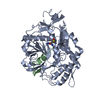
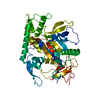
 Links
Links Assembly
Assembly

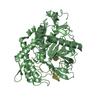
 Components
Components
 Clostridium botulinum (bacteria) / Gene: bonT/F / Plasmid: pET28b / Production host:
Clostridium botulinum (bacteria) / Gene: bonT/F / Plasmid: pET28b / Production host: 
 Escherichia coli (E. coli) / Strain (production host): BL21(DE3)RIPL
Escherichia coli (E. coli) / Strain (production host): BL21(DE3)RIPL bontoxilysin
bontoxilysin Water
Water X-RAY DIFFRACTION / Number of used crystals: 1
X-RAY DIFFRACTION / Number of used crystals: 1  Sample preparation
Sample preparation
 SYNCHROTRON / Site:
SYNCHROTRON / Site:  NSLS
NSLS  / Beamline: X12C / Wavelength: 1.08 Å
/ Beamline: X12C / Wavelength: 1.08 Å : 1.08 Å / Relative weight: 1
: 1.08 Å / Relative weight: 1  Processing
Processing :
:  MOLECULAR REPLACEMENT
MOLECULAR REPLACEMENT Movie
Movie Controller
Controller


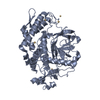
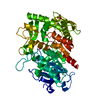
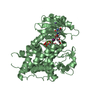

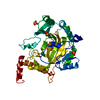
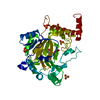

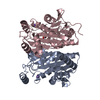



 PDBj
PDBj




















